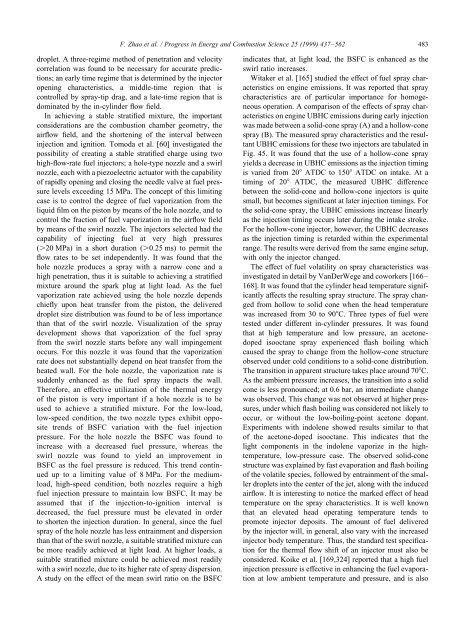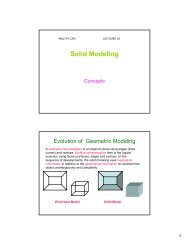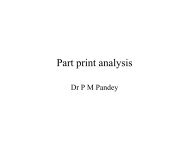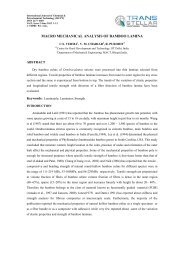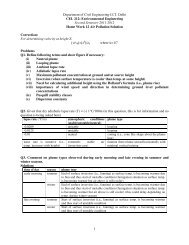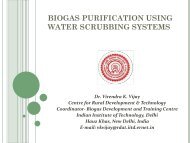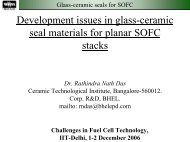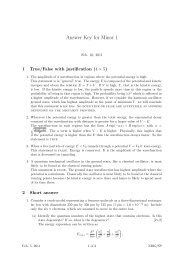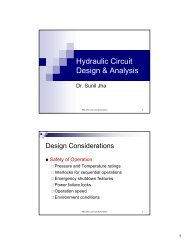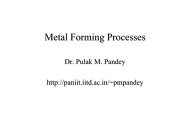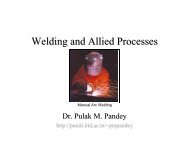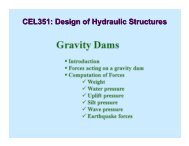Automotive spark-ignited direct-injection gasoline engines
Automotive spark-ignited direct-injection gasoline engines
Automotive spark-ignited direct-injection gasoline engines
Create successful ePaper yourself
Turn your PDF publications into a flip-book with our unique Google optimized e-Paper software.
F. Zhao et al. / Progress in Energy and Combustion Science 25 (1999) 437–562 483<br />
droplet. A three-regime method of penetration and velocity<br />
correlation was found to be necessary for accurate predictions;<br />
an early time regime that is determined by the injector<br />
opening characteristics, a middle-time region that is<br />
controlled by spray-tip drag, and a late-time region that is<br />
dominated by the in-cylinder flow field.<br />
In achieving a stable stratified mixture, the important<br />
considerations are the combustion chamber geometry, the<br />
airflow field, and the shortening of the interval between<br />
<strong>injection</strong> and ignition. Tomoda et al. [60] investigated the<br />
possibility of creating a stable stratified charge using two<br />
high-flow-rate fuel injectors; a hole-type nozzle and a swirl<br />
nozzle, each with a piezoelectric actuator with the capability<br />
of rapidly opening and closing the needle valve at fuel pressure<br />
levels exceeding 15 MPa. The concept of this limiting<br />
case is to control the degree of fuel vaporization from the<br />
liquid film on the piston by means of the hole nozzle, and to<br />
control the fraction of fuel vaporization in the airflow field<br />
by means of the swirl nozzle. The injectors selected had the<br />
capability of injecting fuel at very high pressures<br />
(20 MPa) in a short duration (0.25 ms) to permit the<br />
flow rates to be set independently. It was found that the<br />
hole nozzle produces a spray with a narrow cone and a<br />
high penetration, thus it is suitable to achieving a stratified<br />
mixture around the <strong>spark</strong> plug at light load. As the fuel<br />
vaporization rate achieved using the hole nozzle depends<br />
chiefly upon heat transfer from the piston, the delivered<br />
droplet size distribution was found to be of less importance<br />
than that of the swirl nozzle. Visualization of the spray<br />
development shows that vaporization of the fuel spray<br />
from the swirl nozzle starts before any wall impingement<br />
occurs. For this nozzle it was found that the vaporization<br />
rate does not substantially depend on heat transfer from the<br />
heated wall. For the hole nozzle, the vaporization rate is<br />
suddenly enhanced as the fuel spray impacts the wall.<br />
Therefore, an effective utilization of the thermal energy<br />
of the piston is very important if a hole nozzle is to be<br />
used to achieve a stratified mixture. For the low-load,<br />
low-speed condition, the two nozzle types exhibit opposite<br />
trends of BSFC variation with the fuel <strong>injection</strong><br />
pressure. For the hole nozzle the BSFC was found to<br />
increase with a decreased fuel pressure, whereas the<br />
swirl nozzle was found to yield an improvement in<br />
BSFC as the fuel pressure is reduced. This trend continued<br />
up to a limiting value of 8 MPa. For the mediumload,<br />
high-speed condition, both nozzles require a high<br />
fuel <strong>injection</strong> pressure to maintain low BSFC. It may be<br />
assumed that if the <strong>injection</strong>-to-ignition interval is<br />
decreased, the fuel pressure must be elevated in order<br />
to shorten the <strong>injection</strong> duration. In general, since the fuel<br />
spray of the hole nozzle has less entrainment and dispersion<br />
than that of the swirl nozzle, a suitable stratified mixture can<br />
be more readily achieved at light load. At higher loads, a<br />
suitable stratified mixture could be achieved most readily<br />
with a swirl nozzle, due to its higher rate of spray dispersion.<br />
A study on the effect of the mean swirl ratio on the BSFC<br />
indicates that, at light load, the BSFC is enhanced as the<br />
swirl ratio increases.<br />
Witaker et al. [165] studied the effect of fuel spray characteristics<br />
on engine emissions. It was reported that spray<br />
characteristics are of particular importance for homogeneous<br />
operation. A comparison of the effects of spray characteristics<br />
on engine UBHC emissions during early <strong>injection</strong><br />
was made between a solid-cone spray (A) and a hollow-cone<br />
spray (B). The measured spray characteristics and the resultant<br />
UBHC emissions for these two injectors are tabulated in<br />
Fig. 45. It was found that the use of a hollow-cone spray<br />
yields a decrease in UBHC emissions as the <strong>injection</strong> timing<br />
is varied from 20 ATDC to 150 ATDC on intake. At a<br />
timing of 20 ATDC, the measured UBHC difference<br />
between the solid-cone and hollow-cone injectors is quite<br />
small, but becomes significant at later <strong>injection</strong> timings. For<br />
the solid-cone spray, the UBHC emissions increase linearly<br />
as the <strong>injection</strong> timing occurs later during the intake stroke.<br />
For the hollow-cone injector, however, the UBHC decreases<br />
as the <strong>injection</strong> timing is retarded within the experimental<br />
range. The results were derived from the same engine setup,<br />
with only the injector changed.<br />
The effect of fuel volatility on spray characteristics was<br />
investigated in detail by VanDerWege and coworkers [166–<br />
168]. It was found that the cylinder head temperature significantly<br />
affects the resulting spray structure. The spray changed<br />
from hollow to solid cone when the head temperature<br />
was increased from 30 to 90C. Three types of fuel were<br />
tested under different in-cylinder pressures. It was found<br />
that at high temperature and low pressure, an acetonedoped<br />
isooctane spray experienced flash boiling which<br />
caused the spray to change from the hollow-cone structure<br />
observed under cold conditions to a solid-cone distribution.<br />
The transition in apparent structure takes place around 70C.<br />
As the ambient pressure increases, the transition into a solid<br />
cone is less pronounced; at 0.6 bar, an intermediate change<br />
was observed. This change was not observed at higher pressures,<br />
under which flash boiling was considered not likely to<br />
occur, or without the low-boiling-point acetone dopant.<br />
Experiments with indolene showed results similar to that<br />
of the acetone-doped isooctane. This indicates that the<br />
light components in the indolene vaporize in the hightemperature,<br />
low-pressure case. The observed solid-cone<br />
structure was explained by fast evaporation and flash boiling<br />
of the volatile species, followed by entrainment of the smaller<br />
droplets into the center of the jet, along with the induced<br />
airflow. It is interesting to notice the marked effect of head<br />
temperature on the spray characteristics. It is well known<br />
that an elevated head operating temperature tends to<br />
promote injector deposits. The amount of fuel delivered<br />
by the injector will, in general, also vary with the increased<br />
injector body temperature. Thus, the standard test specification<br />
for the thermal flow shift of an injector must also be<br />
considered. Koike et al. [169,324] reported that a high fuel<br />
<strong>injection</strong> pressure is effective in enhancing the fuel evaporation<br />
at low ambient temperature and pressure, and is also


